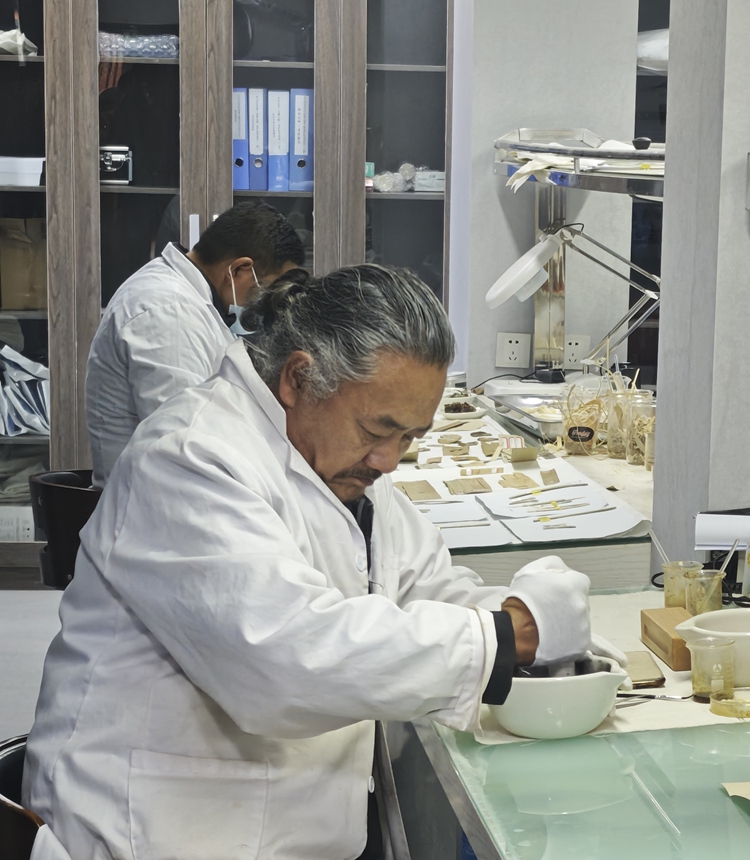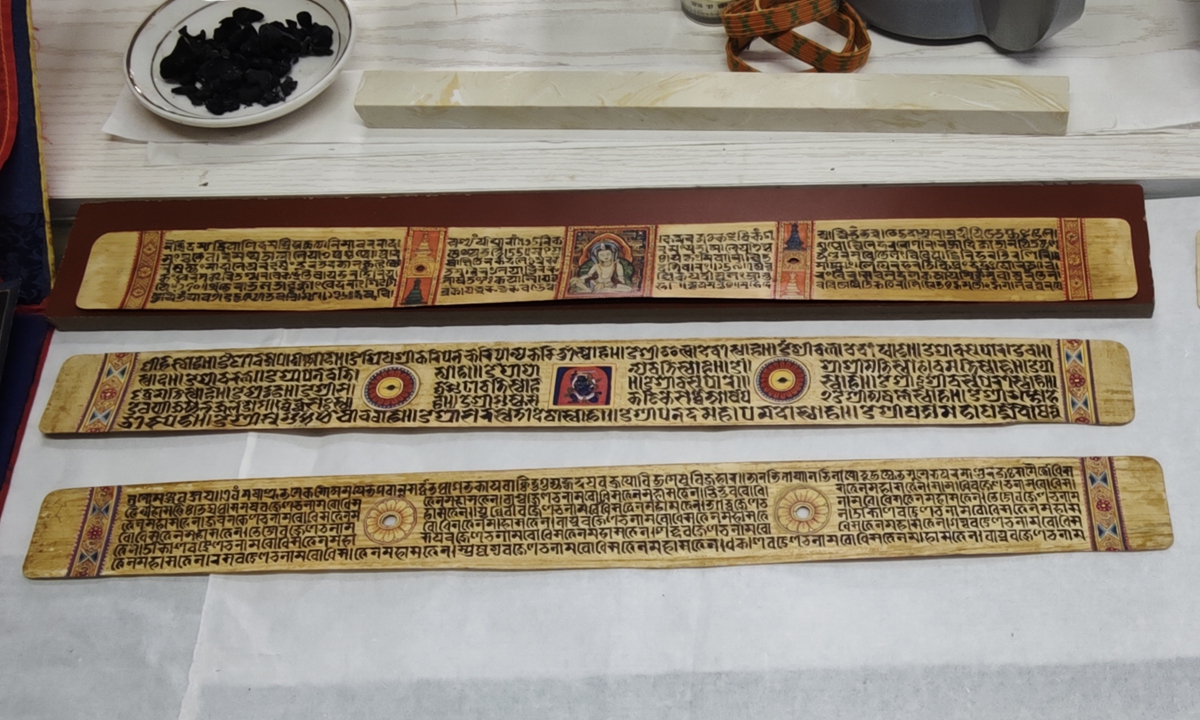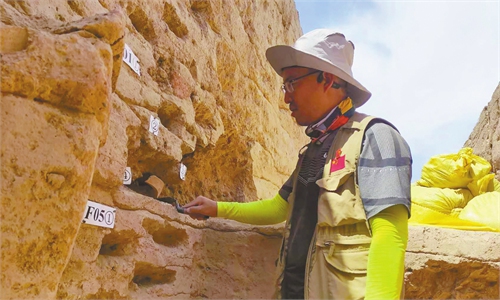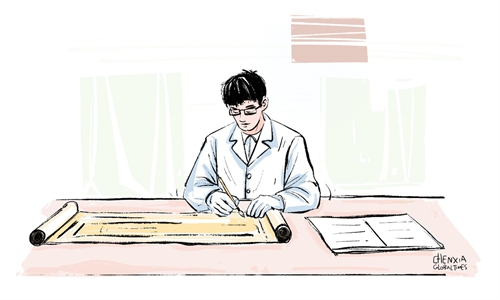ARTS / ART
Tradition, tech unite to rescue Potala Palace’s palm-leaf legacy
Ancient wisdom meets modern science

Cultural relic restorers repair palm-leaf manuscripts in the cultural relic restoration room at the Potala Palace on May 25, 2025. Photo: Chen Xi/GT
Nestled within the majestic Potala Palace in Lhasa, Southwest China's Xizang Autonomous Region, a small yet bustling restoration studio hums with activity. Three cultural relic restorers, clad in white coats, are engrossed in their respective tasks.One traces ink onto print, another intently compares various materials with the one on his hand, while the third conducts what appears to be a complex chemical experiment while flanked by an array of bottles and jars.
Little do they know, their efforts are part of a much larger mission: The painstaking restoration of ancient palm-leaf manuscripts, some of the world's most precious cultural relics.

The Potala Palace Photo: VCG
Struggles behind restorationPalm-leaf manuscripts of Buddhist sutras, ancient scriptures inscribed on the leaves of the pattra tree, originated in India and played a pivotal role in the spread of Buddhism in the world, including in China.
Such manuscripts are mostly written in Sanskrit. Considered unique treasures with unparalleled historical and literary value, these manuscripts cover a vast array of subjects, from Buddhist teachings and literature, to history, philosophy, medicine, and astronomy in South and Central Asia.
Media sources reported that Xizang is home to over 1,000 volumes (varieties) of Sanskrit palm-leaf manuscripts, including some paper-based Sanskrit and Tibetan transcriptions, totaling nearly 60,000 leaves. Among these are many rare, fine, and valuable editions.
"More than 60 percent of the surviving palm-leaf manuscripts are housed in the Potala Palace," Danrao, a research fellow at the cultural heritage protection department of the Potala Palace management office, told the Global Times.
However, the ravages of time have left some of them damaged and deteriorating, necessitating urgent restoration. Danrao pointed out that the palm-leaf manuscripts have suffered various forms of damage such as insect infestation and curling.
The team of restorers is as diverse as the challenges they face. Among them is Tsering Wangdui, a renowned Tibetan master of Thangka painting.
Despite his success in the art world, he volunteered to join the studio, hoping to apply traditional Thangka and Tibetan paper restoration techniques to the manuscripts.
"My greatest wish is to bring these fragmented manuscripts back to their former glory," he said.
Unlike traditional craftsmen, Leng Benkai, a young staff member from the palace's cultural relics preservation department, joined the project to provide technical support.
He emphasized the challenges in sourcing materials.
The Potala Palace's palm-leaf manuscripts are primarily handwritten copies. The team tried to get materials from India, but the pattra tree, once abundant in India, is now hard to transform here.
Fortunately, suitable palm leaves, sourced from Southwest China's Yunnan Province, undergo processes like silk extraction, cutting, and powdering to become viable repair materials.
"For small pits or pinholes, we grind the palm-leaf fibers into powder for filling," Leng explained. "But for now, we focus on solving the core restoration issues rather than aging the repaired parts on purpose."
The development of adhesives, in particular, has also been a labor-intensive endeavor. Drawing on Tibetan traditional craftsmanship and international research, the team experimented with numerous materials, including plant-based gums, elm bark, and even ox glue and rock sugar.
After countless trials, they settled on a plant-based adhesive. According to Leng, preparing a piece of palm-leaf manuscript for restoration is a long process. After thorough cleaning and drying, conservators assess the damage, whether it be warping, tears, or insect infestations, before devising a customized plan.
There are also some palm-leaf manuscripts abroad. However, due to Xizang's special climatic conditions, the restoration methods other people propose, like those in historical records, are for reference only. To achieve effective restoration, tailor-made approaches are needed for each palm leaf, Leng noted.
"Each leaf's restoration can take half a month to a full month," he added.

The replicas of palm-leaf manuscripts Photo: Chen Xi/GT
Collaborative effortsThe restoration of palm-leaf manuscripts is not just a solitary pursuit but a collective endeavor involving multiple parties.
Danrao introduced that since the Potala Palace's Palm-Leaf Manuscripts and Ancient Literature Protection Project launched in 2019, it has entered its third phase, encompassing rescue operations, preventive measures, and digital preservation.
Rescue operations target the hands-on restoration work, while preventive protection focuses on monitoring the storage environment.
Digital preservation, a highlight of the third phase, aims to digitize the manuscripts, extract Tibetan text through Optical Character Recognition (OCR) technology, which converts images of text on the manuscripts into machine-readable text formats, and creates an online database.
This innovation reduces the need to handle the delicate physical manuscripts, ensuring their long-term preservation. So far, the team has completed the condition assessment of all 465 volumes of palm-leaf manuscripts (around 29,380 leaves), drawn up the relevant maps and reports, and produced OCR-based digital copies of 115 volumes, according to the National Cultural Heritage Administration.
To support this ambitious project, Xizang has established a leading group under the collaboration with cultural institutions and universities, along with a special working team implementing monthly inspections.
Additionally, Tibetan master craftsmen, mural inheritors, and staff from other disciplines contribute traditional wisdom, and blend it with modern restoration techniques.
Leng, from Central China's Henan Province, said he came to Xizang under the support of "Go West" program, a program that offered young Chinese a chance to spend a year or more volunteering in the country's vast western regions to inject new ideas and vigor into the regions with huge development potential.
"Though a chemistry major, I feel honored to restore national first-class relics like palm-leaf manuscripts," he said.




